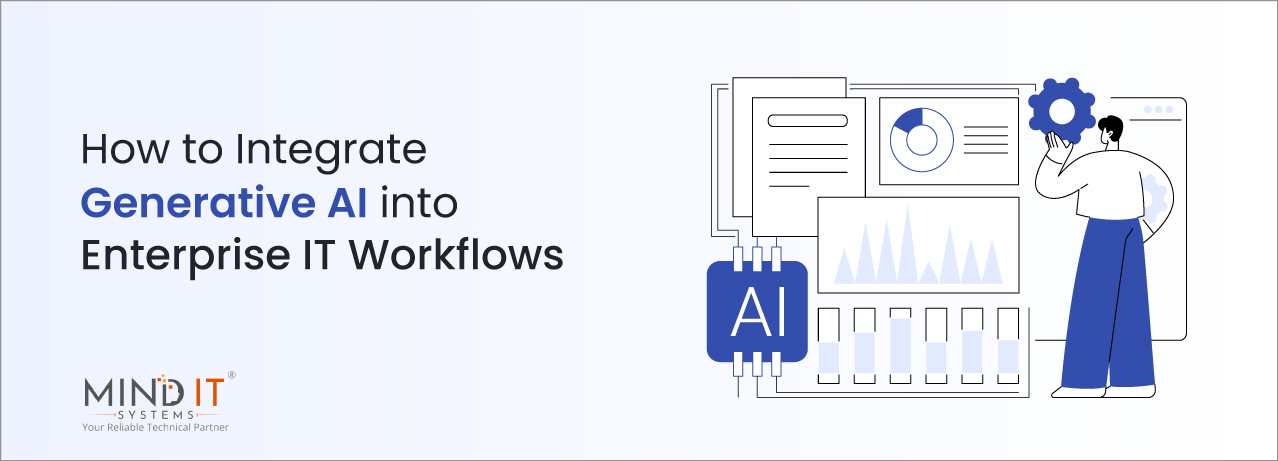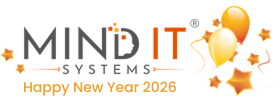
Generative AI integration into core enterprise IT systems and workflows
Introduction
Introducing integrating generative AI into enterprise IT is reshaping how business operates, automatic workflow, enhancing responsiveness and modernising legacy infrastructure. This guide will walk through some practical steps and strategies to explore the best practices for implementing generative AI deployment for enterprise infrastructure.
How to Integrate Generative AI into Enterprise IT Workflows
The integrative process starts with identifying high-impact areas where generative AI can bring measurable improvements. Instead of enforcing AI into every process enterprise should focus on targeted workflows, like repetitive tasks, resource intensive tasks which can be a boon to the IT employees.
Step-by-step approach:
Assess Readiness and Identify Opportunities
- Evaluate the existing IT system: Conduct an audit that evaluates the existing data which is available for integrating AI into IT workflows.
- Identify the Gap: Point out the core area where you find a gap while evaluating the data. Incorporating AI can bridge that and form a holistic system
Choose the Right AI Models and Tools
Selecting the right AI architecture is critical to building solutions that are scalable, reliable, secure and high-performance. AI models should be designed according to the enterprise and business needs.
These are six common proven integrated approaches:
1. Microservices for Scalability:
This model is best for banking, fintech and large-scale e-commerce sectors. In this field a high transaction platform with high speed is required. The AI process would be ideal for this uptime.
2. API Gateway & Service Meshes for Secure Access
Suits for manufacturing, telecom, government and regulated industries. As this sector has strict governance and high grade security. This module can cut unauthorised access by80% and reduce anomaly investigation from days to hours.
3. Embedded Data Pipeline for Accuracy
This module feature can help in supply chain, retail analytics and resource monitoring. Industries that rely on continuous operational data need instant accurate insight.
4. Serverless Functions for Flexibility
Optimised for startups, SMEs, marketing automation and event-based workflow. Companies which do not need any heavy software for their workflow can save bulk cost while automating routine task like email alerts, quick document summaries.
5. Edge & On-Premises AI for Low Latency
Best suited for healthcare, finance, IoT, defense, and autonomous systems. Without depending on cloud connectivity, it can offer you data privacy and instant decision making.
6. Hybrid Cloud for Balanced Workload
Legal enterprises, healthcare, and banking can be a useful application of this module. As it offers the best worlds of data security for regulated content and scalable compute for heavy AI workload.
Key Platform for AI Ecosystem
- Modern Development: PyTorch, TensorFlow, Hugging Face
- ML Platform: Kubeflow, MLflow, Amazon SageMaker
- Feature Store: Fest, Tecton
- Orchestration & Monitoring: Open Shift, Prometheus, Datadog, ELK Stack
- Government & Compliances: Colibra, Apache Atlas, IBM AI Fairness 360, SHAP, and Open Policy Agent
Pilot and Iterate in Context
Pilots at low risk environments validate AI on non-critical workflows such as drafts, summaries and suggestions to avoid the risk of accuracy, cost, and compliance before rollout.
Pilot Execution Roadmap
- Choose What to Test: Select a non-critical workflow with measurable value like (time saved, error deduction), also define the key parameters to measure like (accepted rate of quality, safety gate, cost request)
- Create a Safe Testing Space: To ensure security run the test first in an isolated system that does not disrupt the main system. In the initial stage use fake data to avoid privacy risk once it works accurately and gradually allow real data for the workflow.
- Build and Test the AI Model: Train the AI with relevant example ensure it crosses the basic test before actual use in the field. Also, remember to keep a note of the version used and the commands used during training.
- Test Behind the Scenes: Run the AI parallel with your current system without affecting the real users. Monitor the speed and cost against the existing way of doing things.
- Keep People in Loop (Human Review): Get practical human reviews like HR staff or customer service agents. Get formal feedback with options of “approved, edit/upgrade, or reject”
- Monitor Closely: Track the performance, speed, error and safety issues in real time. Set high alerts for unusual behavior or activities.
- Decide the Next Steps: Review the results based on time, cost efficiency, accuracy and safety record. Fortunately, if everything falls in place, move for a small scale live rollout. If not, go for further development and reset.
Best Practices for Implementing Generative AI in Core IT Systems
Bringing generative AI in core IT systems is not just about installing a new AI tool; it is about reshaping how your enterprise operates, innovates, and delivers value. Right from the starting automating workflow to enhance decision making, generative AI has the potential to unlock significant efficiency and credibility. Below are the key best practices to help you integrate generative AI into your IT infrastructure.
1. Define Clear Goals and Success Metrics
Before persuing set a measurable target like reducing the resolution time by 40% or automating 60% of provisioning tasks. This ensures your AI-powered enterprise IT strategy aligns with tangible ROI.
2. Promote AI-Driven Workflow Automation
Automate repeatable tasks like patch deployments, log analysis, or user authentication workflows. This shifts IT teams focuses from manual labor to strategic priorities and innovation.
3. Drive Legacy System Modernization with AI
COBOL to Java, standard API translation or rebuild monolithic services accelerate the transformation with microservices patterns. This approach helps modernize without radical re-engineering.
4. Ensure Governance, Security and Compliance
Integrating AI responsibility with data anonymization can be checked with regulations like GDPR or industry-specific mandates. A validated AI output rigorously implemented to control the access.
5. Invest in Team Training and Change Management
AI-power workflows require new skills. Offer workshops on prompt engineering, monitoring and ethical use of AI. Moreover, addressing concerns proactively positioned AI as a productivity tool, not a job threat.
Scalable Generative AI Deployment for Enterprise Infrastructure
Deploying generative AI at an enterprise level needs a concept beyond experiments it needs scalable, resilient and secure infrastructure. A scalable deployment strategy ensures seamless AI models that are not only but also integrated into existing systems without any disruption. While focusing, the scalability enterprise can benefit multiple departments, applications and geographies ensuring sustainable innovation.
Modular and Hybrid Architectures
Deploying as microservices, organisations should build modular hybrid architectures by containerizing AI services. This approach offers flexibility, for example sensitive data can stay on premises to meet security and compliance requirements. While computational tasks can be handled in the cloud for scalability.
MLOps for Lifecycle Management
Implementing MLOps is an essential factor for managing the entire AI model lifecycle. MLOps pipelines help to versioning the models, track the key metric and automate the deployment and rollback processes. This is essential for model drift which refers to when a model’s performance degrades over time, triggering retraining and ensuring operational consistency.
Continuous Learning and Feedback Loops
It’s important to implement continuous learning and feedback loops to keep AI models relevant and accurate. Information collected from resolved tickets, customer support integration or other outcomes should be fed back into the training program. Regularly retraining models with relevant new data remain aligned with the business context and requirements.
Cost and ROI Monitoring
Lastly, businesses actively monitor cost and returns on investment which is also known as ROI (Return of Investment). By tracking compute usage, API calls and licensing fees any organisation can create a scaling cost against the ROI or KPI (Key Performance Indication)of AI implementation.
Enterprise Use Case for Generative AI in Internal Systems
Generative AI is no longer limited to customer-facing applications, it’s transforming how internal enterprise systems function. By embedding AI into internal workflow, enterprises can reduce manual effort, streamline decision-making and also empower teams with productive insights.
AI-Power Code Generation and Review
AI-powered tools are directly assisting the engineers with coding tasks. This is integrated into (Integrated Development Environments) IDEs and code repositories, using machine learning. Moreover, this can automatically generate unit tests to ensure code quality and identify potential bugs early in the development cycle. This significantly boosts productivity and reduces the time required for code reviews.
Predictive Infrastructure and Maintenance
AI is transforming the IT sector from a reactive to a proactive discipline. Analysing a vast amount of data, network traffic and usage patterns, it can also identify subtle and signs that precede a system failure. This capability is called predictive maintenance. For instance, it can detect the increase of CPU temperature or any hardware failure. Based on this prediction automated action is triggered like proactive resource scaling to anticipate the surge, and minimise the downtime and ensure a reliable system.
Knowledge Management with Retrieval – Augmented Generation (RAG)
Retrieval-Augmented Generation (RAG) is a powerful AI technique that incorporates retrieval specific, factual information, with the generative capabilities of large language models. In simple IT or engineering terms RAG-powered systems act as a super-power search engine for an organization’s internal knowledge base. It is capable of fetching data documentation, pasting incident reports, configuring any details and troubleshooting by understanding natural language. These features empower engineers to diagnose and resolve issues swiftly.
Cybersecurity Detection and Responses
In the landscape of cybersecurity threats, AI proves a significant layer of defense. Generative models and machine learning algorithms are a highly effective baseline of normal system behaviour. It is able to continuously monitor systems for anomalous behaviour or suspicious behaviour or patterns. For example, AI might flag an unusual number of login attempts from a new IP address, or a sudden increase of data transfer from a specific service. It can also alert security teams for deeper human-led investigation to mitigate any threats.
Modernizing Legacy System and Infrastructure
Many organisations are burdened by legacy systems,traditional codebases are difficult to maintain, update, and integrate with modern technology. These AI models can introspect legacy codebases and understand logic and functionality within. This allows fewer applications to interact within the old system.
Conclusion
Integrating generative AI into enterprise IT isn’t just about adding new technology; it’s about workflow with a strategic step-by-step process. This journey usually begins with identifying key opportunities, selecting the right module and hybrid architectures, and implementing a pilot program for validation. Furthermore, leveraging AI for code generation, predictive maintenance, and cybersecurity, businesses can modernise, boost productivity, and ensure strong returns. Ultimately, this transformation allows the company to get modernised by reshaping operations to be more efficient, secure, and innovative.
Share this post
About the Author

Sujoy Roy
(Head – Digital Marketing)
From my teenage time, I had a quench to solve problems and loved leadership. Starting my career in relation management, ignited my passion for managing people. While managing I realized technology needs to be incorporated to keep pace with the changing world & do my work efficiently.

